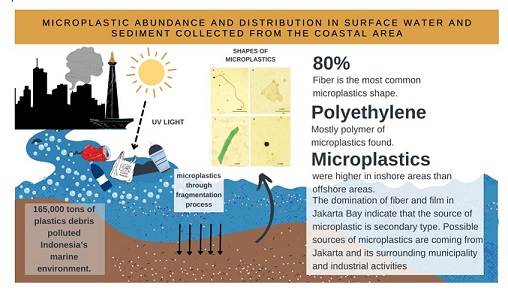Document Type : ORIGINAL RESEARCH ARTICLE
Authors
1 Department of Biology, Faculty of Mathematics and Natural Sciences, Universitas Indonesia, Depok, Indonesia
2 Marine Science Department, Faculty of Mathematics and Natural Sciences, Sriwijaya University, Palembang, Indonesia
3 Marine Science Department, Marine Science and Fisheries Faculty, Udayana University, Jl, Raya Kampus Universitas Udayana, Bukit Jimbaran, Bali, Indonesia
Abstract
BACKGROUND AND OBJECTIVES: Rapid development has increased the microplastics discharges into marine environments, including coastal waters at Jakarta Bay, Indonesia. This study is proposed to assess microplastics abundance and distribution in surface water and sediment from coastal water at Jakarta Bay.
METHODS: The samples were collected from 12 locations representing Ancol, Muara Baru, and Muara Angke - Muara Karang. Samples of water and sediment were extracted to obtain the microplastics. The microplastics were identified based on their morphology (shape) and numbered for their abundance. The polymer of microplastics was determined using Raman Spectrophotometer.
FINDINGS: The results showed that microplastics were successfully identified and counted in water and sediment samples at all collection points. The number of microplastics was 1532 particles in the water sample and 1419 particles in the sediment sample. The shape of microplastics observed in the water and sediment samples were fibers, films, fragments, and pellets. Among those, fiber and film were the most dominant microplastic detected both in surface water and sediment in all locations. Three polymers, namely polyethylene, polypropylene, and polystyrene, were detected in the microplastic samples. These findings prove that microplastics with their various types are capable contaminate the aquatic environment.
CONCLUSION: The most common microplastics shapes in sediment were fiber (55.7%) > film (31.1%) > fragment (9.9%) > pellet (3.2%) and for the surface water were film (53.5%) > fiber (33.9%) > fragment (7.8%) > pellet (4.7%). The abundance of microplastics in the sediment (166.8 particles/kg, 95%CI: 148.0-185.0) was significantly higher (p < 0.05) than in surface water (70.9 particles/L, 95%CI: 55.6-86.2). The abundance of microplastics was significantly different among locations (p < 0.05, F = 2.115), with microplastics in sediments were higher in Ancol, and Muara Angke - Muara Karang have the highest microplastics in surface water. These results can provide valuable information on which parts of the Jakarta Bay areas should be prioritized first regarding microplastics management.
Graphical Abstract
Highlights
- In the study area of Jakarta Bay, the microplastics were found within the different portion;
- Human activities arround the coastal were liable for the increasing of microplastics pollution;
- The total amount of microplastics found in both sediment and surface water was within the kind of fiber;
- Three polymers detected were polyethylene, polypropylene and polystyrene;
- The bouyancy properties and current generate to the distribution of microplastics in surface water.
Keywords
Main Subjects
Open Access
©2022 The author(s). This article is licensed under a Creative Commons Attribution 4.0 International License, which permits use, sharing, adaptation, distribution and reproduction in any medium or format, as long as you give appropriate credit to the original author(s) and the source, provide a link to the Creative Commons license, and indicate if changes were made. The images or other third party material in this article are included in the article’s Creative Commons license, unless indicated otherwise in a credit line to the material. If material is not included in the article’s Creative Commons license and your intended use is not permitted by statutory regulation or exceeds the permitted use, you will need to obtain permission directly from the copyright holder. To view a copy of this license, visit: http://creativecommons.org/licenses/by/4.0/
Publisher’s Note
GJESM Publisher remains neutral concerning jurisdictional claims in published maps and institutional affiliations.
Citation Metrics & Captures
Google Scholar | Scopus | Web of Science | PlumX Metrics | Altmetrics | Mendeley |
Current Publisher
GJESM Publisher



Letters to Editor
[1] Letters that include statements of statistics, facts, research, or theories should include appropriate references, although more than three are discouraged.
[2] Letters that are personal attacks on an author rather than thoughtful criticism of the author’s ideas will not be considered for publication.
[3] Letters can be no more than 300 words in length.
[4] Letter writers should include a statement at the beginning of the letter stating that it is being submitted either for publication or not.
[5] Anonymous letters will not be considered.
[6] Letter writers must include their city and state of residence or work.
[7] Letters will be edited for clarity and length.
Send comment about this article